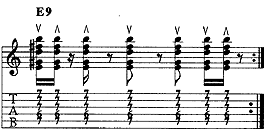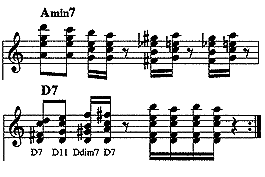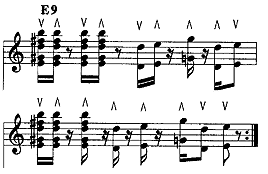Scroll through the lesson and click on notation/video/audio links to load the interactive players.
| Michael Johnson >> 70s Funk Blast >> |
|
|
Please subscribe to get full access to all lessons for only $7.95/month PLUS 1 week free trial.

Riff Interactive lessons are
LESS expensive and
MORE interactive than alternatives!
More Info
|
|
Don Mock:
This is Don Mock and tonight we're going to continue where
we left off in the last lesson with more classic funk guitar rhythm
patterns inspired from the 1970's.
Don Mock:
Before we jump into the example patterns, I'd like to show you a few of my favorite chord movements.
John:
Will we get to learn that lead in your Funky intro as well as the chords?
Don Mock:
Maybe some of it John
Don Mock:
They're borrowed from jazz but work great for funk.
Don Mock:
Here's the first one. It's a four chord move for C7 and can be played up or down any time you are on a C7 chord.
C7 Move

Don Mock:
This one starts with a common C7 voicing followed by a C11, Cdim7 and another C7.
Don Mock:
Notice how the chords create a little melody with the top strings.
Don Mock:
Here is a funk jam in C7 to go along with those chords
Don Mock:
The next movement is similar but on the top four strings.
G7 Move

Don Mock:
This time the first chord is a G13 followed by G11, Bbdim7 and G7.
Don Mock:
When you get the move down a bit move it up to some other keys like A or C etc.
Don Mock:
Both of these movements can be played a few ways when it comes to your picking hand. If you're strumming the chords, you only want the four strings to ring out so you must mute the other two.
Don Mock:
If you want to practice it to a track, slide it up to 'C' and play with the previous jam track.
Don Mock:
It takes a bit of practice to get proficient at muting.
Don Mock:
I use a combination of my left thumb and first and fourth fingers to deaden the strings in these moves.
Don Mock:
Another way to sound the chords is to pluck them with you right hand fingers or a combo of pick/fingers.
Don Mock:
You can get more of a piano sound this way.
Don Mock:
I know a few players who can play real funky with their fingers.
Don Mock:
Let's review a bit about rhythm for a minute.
Don Mock:
A large percentage of funk patterns are based in 16th notes.
Don Mock:
Funk patterns are usually combinations (syncopation) of 16th notes.
Don Mock:
To help with your counting and understanding of the 16th feel, here is a funk comp pattern just on an E9 which uses lots of syncopation.

Don Mock:
Check out the rhythm with this notation
Don Mock:
and notice the up and down strokes shown in the notation
Don Mock:
And I have a jam track to go with this in E
Fuzzbuggy:
how am I supposed to use the fingering for that chord?
Don Mock:
Keep your right hand moving like a metronome. Your left hand should hold the E9 adding pressure to the frets only on the accents.
Don Mock:
here's a tab for the E9 with the fingering...
E9 Chord
Scott:
put your middle finger on the 5th string, index finger on the 4th string abd barre the top three strings with your ring finger
JoeyC:
great way to exlain the counting problem
Don Mock:
You can either strike the strings all the time creating 'chick' sounds on the silent parts, or intentionally miss the strings with your pick.
Don Mock:
Some people say 'scratch' instead of 'chick'
Don Mock:
"Scratching"
Don Mock:
OK guys, let's move on to some funk examples.
Don Mock:
Here is a two bar funk pattern for Am7-D7.

Amin D7 'comp'
Don Mock:
It uses a few Am voicings with a melody line on the top string.
Don Mock:
The second bar features our first chord phrase moved up to D7.
Don Mock:
Is everyone familiar with the term 'comp'?
irene:
compensation
Don Mock:
ha ha... no
Don Mock:
It's short for 'accompaniment'
Don Mock:
Here is a rhythmic audio demo of the comp
Fuzzbuggy:
i'm finding changing these chords hard
Don Mock:
This stuff takes time to learn, be patient
Don Mock:
Keep in mind the melody line you are creating with the chords in this example. Try to make the notes stand out.
Don Mock:
The next example introduces octaves as a great device for adding a fat sound to funk parts.

E7 comp
John:
Do you finger pick the 7-5 and 9-7 parts?
Don Mock:
good question
Don Mock:
It's best to play the octaves with your pick, while muting all the other strings
Don Mock:
I'm playing the octaves with my left-hand 1st and 4th fingers only. (Wes Montgomery style)
Don Mock:
Give it a shot over this E7 Jam Track.
mehl:
how do you mute the other strings then?
Fuzzbuggy:
just use your fretting finger
Don Mock:
It takes practice, BUT you use 2nd and 3rd fingers and maybe your thumb
John:
Let the 1st finger just touch the muted string.
Don Mock:
One more example to play with...
Don Mock:
This example is a combination of a few single notes, 3rds, 4ths and chords.

Comp #3
Don Mock:
The first 3rd in the lick is followed by a C# note before you move up two 1/2 steps to a three-note E7.
Don Mock:
The next part is a riff using single notes and 4th intervals. An E9 is accented on the 'e' of beat four followed by another 3rd interval.
Don Mock:
This last 3rd leads into the first 3rd when you repeat to the beginning.
Don Mock:
Something to remember is that good funk parts are usually simple and not too busy.
Don Mock:
This last example is cool, but might prove to be too busy is many situations.
Don Mock:
You can 'edit' out parts of it until you find the right feel.
Don Mock:
For example, you could leave off the four notes and the last chord playing only the single notes and 4ths.
Don Mock:
Or, leave off the middle part and play only the 3rds and the E9 punch.
Fuzzbuggy:
i should buy myself a chord book
Don Mock:
I don't recommend certain chord books
Don Mock:
The ones with 1000's of chords
Fuzzbuggy:
so which one do you recommend?
Don Mock:
Chords are not the big of deal, in a short period of time, you can learn enough chords to play at any level.
Fuzzbuggy:
yeah, but that'll boost up the process wouldn't it? it'll also help you compose stuff
Don Mock:
Check out Warner's "Ultimate Beginner's" series books or vides.
Scott:
Instead of memorizing a bunch of chords you'll forget, learn here. You'll use these.
Don Mock:
Blues and Rock
Don Mock:
By Keith Wyatt, some of the best stuff I know.
Don Mock:
I have one more jam track to work with, for the last example
Don Mock:
If it's too fast to play with, use the previous jam track I sent out.
Don Mock:
Coming up with good funk rhythm parts is an art.
Don Mock:
The best parts work perfectly with the bass and drums.
Don Mock:
In fact, Funk rhythm sections spend a lot of time working out parts together. The result is often very simple individual parts, but when added to the band sound great.
Don Mock:
that's all I got for today
Don Mock:
Be sure to check out the "lick of the day" for the next few weeks.
Fuzzbuggy:
the thing with my gutiaring is that I really suck at funk, actually i've never even tried funk before
Don Mock:
just expose yourself more to it.
Don Mock:
see you next time
|
<< load notation from left
|
|
<< load audio from left
|
<< load audio from left
|